Looking for healthy alternatives to sugar? Wondering which sweetener options work best for you?
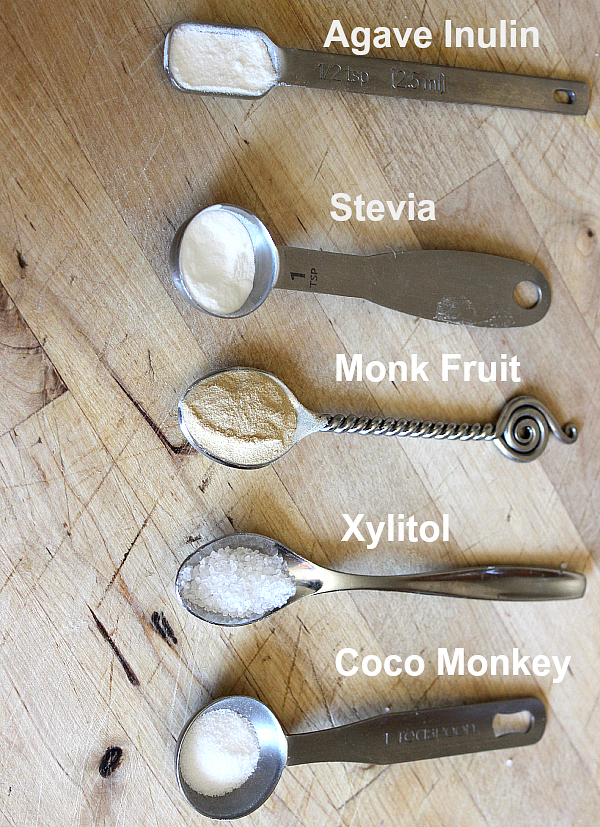
While raw, unpasteurized honey is by far the best option when it comes to natural sweeteners, honey still contains fructose which can be burdensome when consumed in excess. Fructose is metabolized primarily in the liver, kicking the liver into fat storage mode. This can lead to insulin resistance and other health complications.
The following chart shows the similarities between natural sweeteners and manufactured sweeteners. Note that agave offers the highest level of fructose.
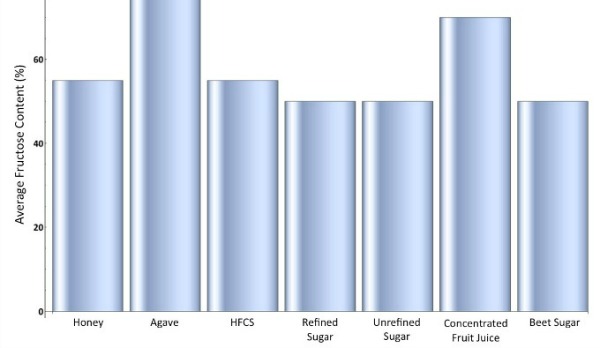
Where does this leave us when it comes to sweetening our food?
Small amounts of raw, unpasteurized honey may be the best option for healthy individuals.
Artificial sweeteners like aspartame and sucralose (Splenda) are 100% chemically derived. As they easily cross the blood brain barrier with the potential for neurological damage, they are best avoided.
Thankfully, there are low-fructose options that work well in moderation.
5 Sweetener Alternatives
1. Stevia
Stevia is a sweetener extracted from the leaves of the plant species Stevia rebaudiana. The leaves have up to 150 times the sweetness of sugar without the fructose. Stevia can leave a bitter aftertaste which may or may not be noticeable. Most commercially available stevia involves some processing, but the carb count is still negligible. Our son with type 1 diabetes prefers stevia over all other sweeteners.
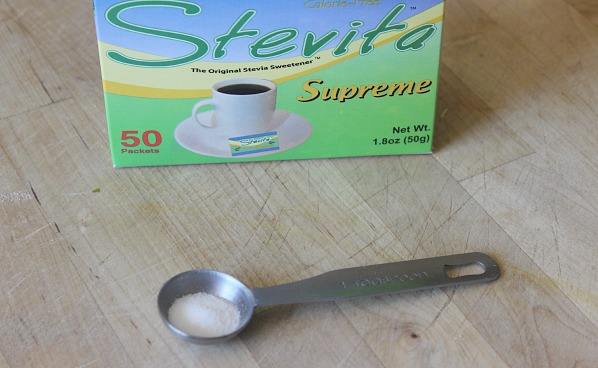
Stevia Sources
Stevita (a blend of stevia and non-GMO birch xylitol)
Mood and Mind (organic white stevia extract powder)
Suede Hills Organic Farm (100% pure green stevia powder)
Liquid stevia:
If you’re so inclined, try your hand at making your own liquid stevia. Find the recipe here.
2. Xylitol
Xylitol is a sugar alcohol appearing naturally in some fruit and vegetable fibers. It is probably the least optimal of the alternative sweeteners.
Xylitol can be extracted from corn husks, sugar cane bagasse (the fibrous material that remains after sugar cane is crushed), and birch. The extraction and processing of xylitol can be problematic, especially when derived from corn.
To avoid corn-based xylitol choose non-GMO birch xylitol. It’s important to note that sugar alcohol is not fully digested by the body and can lead to abdominal pain, cramping, or gas. The lack of digestibility also means that unmetabolized xylitol can create an environment for undesirable bacteria and pathogens.
Xylitol is also toxic to dogs.
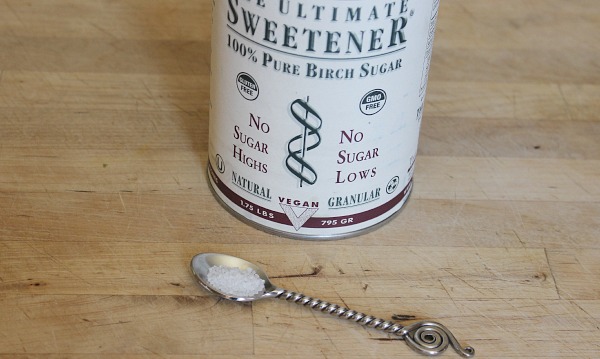
Birch Xylitol Sources
3. Coco Monkey
This is a unique low carb sweetener offered exclusively by Wilderness Family Naturals. It is 100% organic and uses inulin as the base. Inulin is a dietary fiber extracted from the roots or rhizomes of plants with minimal impact on blood sugar. Additional ingredients include freeeze dried coconut water and pure monk fruit.
Coco Monkey has no bitter aftertaste and is water soluble.

Coco Monkey Sources
4. Agave Inulin
This 100% organic sweetener is derived from the blue agave plant. As noted above, inulin is a dietary fiber. According to agave inulin provider Z Natural Foods, 6 pounds of agave is needed to produce 1 pound of powder. Agave inulin is water soluble with a clean sweet flavor.

Agave Inulin Sources
5. Lo Han/ Monk Fruit
Lo han is a sweetener derived from the Chinese monk fruit ( luo han guo in Chinese). It is said to have first been used by monks in China in the 13th century. The fruit itself has been used medicinally for sore throat and coughs for hundreds of years. Monk fruit derives its sweetness from natural antioxidants known as mogrosides.
Monk fruit has minimal calories and is up to 200-500 times sweeter than sugar. It is water soluble and may be the best option in terms of purity and safety when purchased from a reliable source.
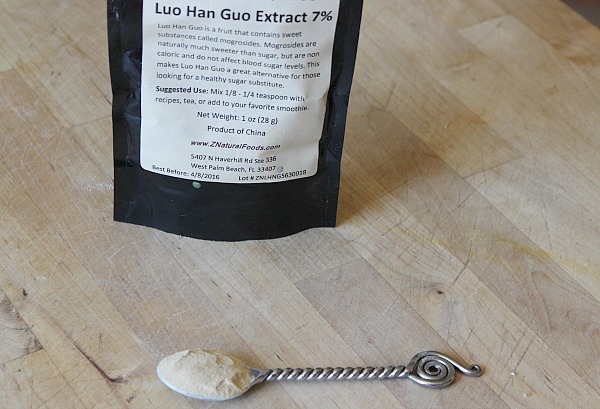
Monk Fruit Sources
*Note: Lakanto is a proprietary blend of non-GMO erythritol (a sugar alcohol derived from corn) and monk fruit.
Rotating and/or combining these sweeteners offers some variety without too much emphasis on one sweetener. I also try to keep sweetened foods to a minimum to keep our tastes diverse and drawn to nutrient dense foods like vegetables, healthy fat and fermented foods.
What about you? What’s your favorite sweetener?
Related Posts
- 38
 Do you find yourself confused by the different options for sweetening your food? Wondering if unrefined sugar is truly better than refined white sugar? Is honey better than agave? How about xylitol or stevia? Refined Vs. Unrefined Sugar In the book, Fat Chance: Beating the Odds Against Sugar, Processed Food,…
Do you find yourself confused by the different options for sweetening your food? Wondering if unrefined sugar is truly better than refined white sugar? Is honey better than agave? How about xylitol or stevia? Refined Vs. Unrefined Sugar In the book, Fat Chance: Beating the Odds Against Sugar, Processed Food,… - 34
- 31








ok this is the second time now im seeing monk fruit this week – i think its a sign 🙂 thanks for the info!
I think you’ll like it Renee. It’s a bit expensive but I’ve made mine last a long time.
I have never heard of monk fruit or coco monkey before! Thanks for the info.
I bet you’ll have fun using either or both with all of your great recipes.
Is agave syrup the same as agave inulin??
Hi Anne,
They are very different. Inulin is fiber and not nearly as sweet. The best explanation comes from Wilderness Family Naturals which sells both agave and inulin.
Inulin is a fiber that cannot be broken down by the digestive enzymes in the stomach or small intestine. Therefore, it remains “intact” until it reaches the large intestine where lactobacillus species of bacteria have been shown to preferentially ferment inulin, especially the Bifidus species. These microscopic organisms predominantly live on undigested fiber in our diet and love inulin. This is why inulin is categorized as a “prebiotic”. Probiotics are the actual “friendly” bacteria that live in your gut. Prebiotics are substances (fiber) that these organisms like to live on.
Inulin, as it is “digested” by “friendly” gut flora converts to fructooligosaccharides (polysaccharides) and eventually these more complex substances are turned into simple sugars, until finally becoming acids of fermentation (also known as short chain fatty acids such as acetic acid, butyric acid and propionic acid). Energy for the cells lining the intestinal tract comes predominantly from these acids of fermentation/short-chain fatty acids.
Because inulin is a fiber, it has no real caloric value, meaning, it does not convert into calories or energy in the body. However, it is the benefits of fiber and the “feeding” of gut flora that make inulin a nice ingredient.
Wilderness Family Naturals’ organic inulin has a neutral, clean, mildly sweet flavor. It is not nearly as sweet as sugar, but definitely enhances sweetness when added to foods. There are 10 grams of fiber in a one ounce serving.
I hope this helps!
I have never heard of coco monkey before. Looks great! Thanks for sharing this with us.
I have never heard of monk fruit or coco monkey before either! Thanks for sharing!
I haven’t heard of a couple of these will go check them out. Thanks for sharing!
Very interesting! Thanks for the information; I hadn’t heard of some of these before. Unfortunately I can’t tolerate any kind of sweetener, sugar or alternative.
Stevia is my favorite. I look forward to learning more about coco monkey. I’m not sure if the fiber would bother me but I like learning about new sweeteners and their sources. Great post!!!
Such a great guide to sweeteners! I use stevia occasionally, sometimes honey for the taste, but other than that I don’t use them. I’d like to mix it up when baking though – and Lo Han is one I hadn’t come across before, would love to try. If it’s good enough for the 15th century Chinese…
Lo Han is my favorite – I agree, if it’s good enough for 15th century Chinese 🙂
Thanks for showing other sugar alternatives. I’m one of the few that absolutely hate stevia (I don’t understand how people think it tastes good) and have been looking for something that won’t make me gag. I’ll look into the monk fruit and coco monkey. Thanks again!
I can’t do stevia either. I love the Coco Monkey and do fine with a little xylitol.
The only stevia my tastebuds can tolerate is powdered stevia leaf. It’s not processed to look like tiny white crystals (I cringe to think about how they do that!). I order it from Mountain Rose Herbs: https://www.mountainroseherbs.com/products/stevia-leaf-powder/profile
Thanks for the suggestion, Sara!
I definitely prefer Stevia. I wonder where coconut sugar lands in this line-up though?
Coconut sugar is still a concentrated sweetener from what I understand and contains fructose. It certainly is unrefined and a better choice than table sugar, though.
I love honey and maple but i’ve been curious about these others so this is great!!! Thanks!
Great post! I’m curious about the flavor profiles…can you describe the taste and what your favorite uses are for these? I’ve only tried Stevia (brand matters- it can be very bitter or leave a hollow sweet taste that doesn’t play well with chocolate or naturally bitter foods) and lo-han or monk fruit, which has a honey like taste. Oh, and some people are allergic or have sensitivities to stevia (it’s in the ragweed family)…do any of the other sweetener options have things that you need to be aware of like that?
Thanks! (I’m a low glycemic sweetener geek if you can’t tell. Ha!)
The closest in taste to sugar in my opinion is xylitol. I love it. The problem is my digestive system doesn’t like it. My kids seem to do fine with it. The Coco-monkey is a fine powder and easy to work with. It is delicious – along the line of monk fruit – since it does contain some. I’m not sure how to explain the inulin…it’s not bitter like stevia can be that’s for sure. I hope I emphasized in the post how important it is to know about xylitol and digestive disruption. Thanks for the question, Gwen!
Which would you suggest to be the best for baking? Do any of these sweeteners crystallize when baking so they would be a good choice for cookies, etc?
My favorite for absolutely everything is the Coco Monkey – the texture works great. Xylitol seems to do fine in baking too. Brandon who does most of the baking says that he likes to use both stevia and xylitol because the xylitol has a long lasting sweetness and the stevia gives it a nice burst of flavor. Nothing weird happens with any of these from my experience, Shelly.
I’ve never heard of CocoMonkey before! Good to know. I also didn’t realize that honey was as high in fructose as HFCS. May I ask where that chart is from?
I use stevia, xylitol and erythritol, in combination or rotation. Erythritol may be easier on the GI tract for more people than xylitol, and it has zero insulin response, while xylitol and most other alternative sweeteners have some impact on blood glucose.
It’s worth pointing out, and I’d appreciate it if you would edit your post to reflect this, that xylitol is extremely toxic for dogs and can be fatal to them. If you use it and have a dog, be very careful that the dog never has access either to the xylitol or anything made from it. Note also that lots of sugarless gums or mints are sweetened with xylitol. Thanks!
I gathered the information on fructose contents from a variety of sources including Dr. Robert Lustig, Dr. Mercola and others. I thought it would be helpful to put it into a graph to show how similar the sugar options are when it comes to fructose. I have mentioned the issue with dogs in a previous post, but added it to this one. Thanks for the feedback.
How about coconut sugar?
Have you looked into the processing of those alternative sweeteners?
At the end of the day they are processed and as you mentioned can be GMO etc…
Hard choice! Thanks for this very interesting site. Marylise
Yes, I’m aware of the processing of some of these sweeteners. The bottom line is to minimize all sweeteners. Coconut sugar has quite a bit of fructose so I don’t use that as an alternative. Our son has type 1 diabetes and it sends him high whereas these alternatives do not. No perfect sweetener that’s for sure! Thanks for the question.
my FAVORITE ‘suguh’?? well sometimes i just stir with my “finguh”. Hubs says it works particular’ gooooood with ice tea! (15 years ago after Dad was diagnosed with diabetes, I moved to NC where tea is SRYUP! i decided i was old enough I should make changes TOO & that was the 1st to go.)
Last week stirrin’ with my finguh worked out well when i made persimmon pudding (British style pudding) & used 1/4 of the recommended sugar.
Thanks for your great article. Do you have any thoughts on brown rice syrup?
Anne,
Brown rice syrup is still a sugar, but as I understand it is lower in fructose. So it seems to be a better option than agave or cane sugar.
Have you ever used Monk Fruit or Stevia? They are neither one sweet. I have seen so many times they are 100 or more times sweeter than sugar and that is just not true. By the time you add enough to even get kinda sweet they are so bitter you can’t drink your drink. And hasn’t it been found out agave is not good. Is that also true of agave insulin?
Agave inulin is different than the syrup. It’s not as sweet as stevia or monk fruit. Everyone is so different in how they respond to sweeteners. No matter what the sweetener, less is more that’s for sure.
As a Type II diabetic, I am trying to get off artificial sweeteners as a matter of principle, so I’ve tried several. While I do like Splenda, it’s artificial. I recently tried Monk Fruit powder (80% pure, not a blend) and Stevia powder (90% steviosides, not a blend). I get mine from Nuts.com. I really like monk fruit for baking. I make a flaxseed chocolate muffin that I really like.
I like them both, but they’re slightly different and I wonder if a blend of the two would “level out” the sweetness? Does anyone have any experience doing this?
I mix my sweeteners for more flavor and diversity. I would try it and see what you think!
I have trouble with sugar alcohols, I cannot digest them. I was wondering in your opinion which sugar alternative would you suggest for a sensitive gut? Thank you so much for sharing your insights on sugar.
I do best with the Coco Monkey linked above. My son does great with stevia. I’m with you on the sugar alcohols.
Hi Andrea,
I’ve found found that Truvia, which is made from the Stevia plant, gives me loose stools and full-blown diarrhea if I have 2 packets in coffee. Have you heard anything negative like that about Stevia or any other of the sweeteners you recommend?
Dona
Truvia also has erythritol in it, which is a sugar alcohol and is not digested. So for those who are sensitive to xylitol or any sugar alcohol, they could be sensitive to erythritol which I’m guessing is the problem for you rather than stevia.
Is it possible to make liquid stevia by using water instead of vodka? dont like alcohol. Thank you. Adel
Not sure on that. It would need to be refrigerated for sure.